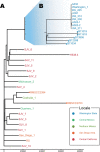Was Coccidioides a Pre-Columbian Hitchhiker to Southcentral Washington?
- PMID: 36880777
- PMCID: PMC10128028
- DOI: 10.1128/mbio.00232-23
Was Coccidioides a Pre-Columbian Hitchhiker to Southcentral Washington?
Abstract
Coccidioides immitis, a pathogenic environmental fungus that causes Valley fever (coccidioidomycosis) primarily in the American Southwest and parts of Central and South America, has emerged over the past 12 years in the Columbia River Basin region, near the confluence with the Yakima River, in southcentral Washington state, USA. An initial autochthonous Washington human case was found in 2010, stemming from a wound derived from soil contamination during an all-terrain vehicle crash. Subsequent analysis identified multiple positive soil samples from the park where the crash occurred (near the Columbia River in Kennewick, WA), and from another riverside location several kilometers upstream from the park location. Intensified disease surveillance identified several more cases of coccidioidomycosis in the region that lacked any relevant travel history to known endemic locales. Genomic analysis of both patient and soil isolates from the Washington cases determined that all samples from the region are phylogenetically closely related. Given the genomic and the epidemiological link between case and environment, C. immitis was declared to be a newly endemic fungus in the region, spawning many questions as to the scope of its presence, the causes of its recent emergence, and what it predicts about the changing landscape of this disease. Here, we review this discovery through a paleo-epidemiological lens in the context of what is known about C. immitis biology and pathogenesis and propose a novel hypothesis for the cause of the emergence in southcentral Washington. We also try to place it in the context of our evolving understanding of this regionally specific pathogenic fungus.
Keywords: Coccidioides; genomics; paleo-epidemiology.
Conflict of interest statement
The authors declare no conflict of interest.
Figures


Similar articles
-
Sexual Harassment and Prevention Training.2024 Mar 29. In: StatPearls [Internet]. Treasure Island (FL): StatPearls Publishing; 2025 Jan–. 2024 Mar 29. In: StatPearls [Internet]. Treasure Island (FL): StatPearls Publishing; 2025 Jan–. PMID: 36508513 Free Books & Documents.
-
Coccidioidomycosis in Northern Arizona: an Investigation of the Host, Pathogen, and Environment Using a Disease Triangle Approach.mSphere. 2022 Oct 26;7(5):e0035222. doi: 10.1128/msphere.00352-22. Epub 2022 Aug 16. mSphere. 2022. PMID: 35972134 Free PMC article.
-
Signs and symptoms to determine if a patient presenting in primary care or hospital outpatient settings has COVID-19.Cochrane Database Syst Rev. 2022 May 20;5(5):CD013665. doi: 10.1002/14651858.CD013665.pub3. Cochrane Database Syst Rev. 2022. PMID: 35593186 Free PMC article.
-
Systemic pharmacological treatments for chronic plaque psoriasis: a network meta-analysis.Cochrane Database Syst Rev. 2021 Apr 19;4(4):CD011535. doi: 10.1002/14651858.CD011535.pub4. Cochrane Database Syst Rev. 2021. Update in: Cochrane Database Syst Rev. 2022 May 23;5:CD011535. doi: 10.1002/14651858.CD011535.pub5. PMID: 33871055 Free PMC article. Updated.
-
Short-Term Memory Impairment.2024 Jun 8. In: StatPearls [Internet]. Treasure Island (FL): StatPearls Publishing; 2025 Jan–. 2024 Jun 8. In: StatPearls [Internet]. Treasure Island (FL): StatPearls Publishing; 2025 Jan–. PMID: 31424720 Free Books & Documents.
Cited by
-
Understanding the exposure risk of aerosolized Coccidioides in a Valley fever endemic metropolis.Sci Rep. 2024 Jan 15;14(1):1311. doi: 10.1038/s41598-024-51407-x. Sci Rep. 2024. PMID: 38225347 Free PMC article.
-
Suspected Acute Pulmonary Coccidioidomycosis in Traveler Returning to Switzerland from Peru.Emerg Infect Dis. 2024 Nov;30(11):2432-2435. doi: 10.3201/eid3011.241034. Emerg Infect Dis. 2024. PMID: 39447191 Free PMC article.
References
-
- Sharpton TJ, Stajich JE, Rounsley SD, Gardner MJ, Wortman JR, Jordar VS, Maiti R, Kodira CD, Neafsey DE, Zeng Q, Hung C-Y, McMahan C, Muszewska A, Grynberg M, Mandel MA, Kellner EM, Barker BM, Galgiani JN, Orbach MJ, Kirkland TN, Cole GT, Henn MR, Birren BW, Taylor JW. 2009. Comparative genomic analyses of the human fungal pathogens Coccidioides and their relatives. Genome Res 19:1722–1731. doi:10.1101/gr.087551.108. - DOI - PMC - PubMed
Publication types
MeSH terms
Substances
Grants and funding
LinkOut - more resources
Full Text Sources
Medical
Miscellaneous

